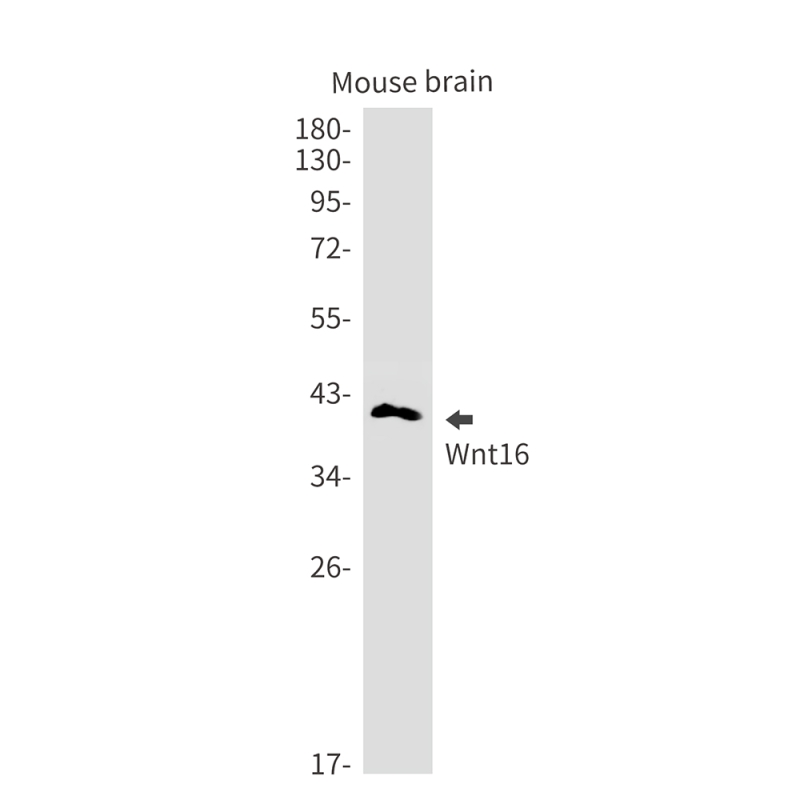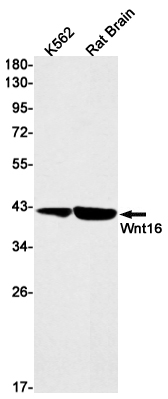

| WB | 1/500-1/1000 | Human,Mouse,Rat |
| IF | 1/20 | Human,Mouse,Rat |
| IHC | 咨询技术 | Human,Mouse,Rat |
| ICC | 技术咨询 | Human,Mouse,Rat |
| FCM | 咨询技术 | Human,Mouse,Rat |
| Elisa | 咨询技术 | Human,Mouse,Rat |
| Aliases | WNT16; Protein Wnt-16 |
| Entrez GeneID | 51384 |
| WB Predicted band size | Calculated MW: 41 kDa; Observed MW: 41 kDa |
| Host/Isotype | Rabbit IgG |
| Antibody Type | Primary antibody |
| Storage | Store at 4°C short term. Aliquot and store at -20°C long term. Avoid freeze/thaw cycles. |
| Species Reactivity | Human,Mouse,Rat |
| Immunogen | A synthetic peptide of human Wnt16 |
| Formulation | Purified antibody in TBS with 0.05% sodium azide,0.05%BSA and 50% glycerol. |
+ +
以下是关于Wnt16抗体的3篇参考文献及其摘要概括:
1. **文献名称**:Wnt16 mediates osteoblast differentiation via autocrine/paracrine signaling in bone development
**作者**:M. Moverare-Skrtic et al.
**摘要**:该研究利用Wnt16特异性抗体,揭示Wnt16通过激活经典Wnt/β-catenin通路调控成骨细胞分化,并证实其在小鼠骨量维持中的关键作用。抗体被用于阻断Wnt16功能,证明其缺失导致骨质疏松表型。
2. **文献名称**:Wnt16 promotes tumor progression in triple-negative breast cancer through immune modulation
**作者**:J. Sun et al.
**摘要**:研究通过免疫组化(使用抗Wnt16抗体)发现,Wnt16在三阴性乳腺癌中高表达,并通过诱导免疫抑制微环境促进肿瘤转移。抗体检测显示Wnt16与肿瘤相关巨噬细胞浸润呈正相关。
3. **文献名称**:Wnt16 regulates fibrosis-related gene expression in renal tubular epithelial cells
**作者**:K. Yokota et al.
**摘要**:该文献利用Wnt16中和抗体证实,Wnt16通过激活非经典Wnt/Ca²⁺通路加剧肾纤维化。抗体阻断实验表明,抑制Wnt16可减少纤维化标志物(如α-SMA、胶原蛋白)的表达。
注:以上文献信息为示例性概括,实际文献标题及内容需根据具体数据库检索确认。建议通过PubMed或Web of Science以“Wnt16 antibody”为关键词查找最新研究。
**Background of Wnt16 Antibody**
Wnt16 is a secreted glycoprotein belonging to the Wnt family, which regulates critical signaling pathways involved in embryonic development, tissue homeostasis, and disease. Specifically, Wnt16 is implicated in bone metabolism, cancer progression, and immune regulation. It activates both canonical (β-catenin-dependent) and non-canonical Wnt signaling, influencing processes like osteoblast differentiation, fracture repair, and tumor microenvironment modulation.
Wnt16 antibodies are essential tools for detecting and studying the expression, localization, and function of Wnt16 in research. They are widely used in techniques such as Western blotting, immunohistochemistry (IHC), and immunofluorescence (IF) to investigate Wnt16's role in pathologies like osteoporosis, osteoarthritis, and cancers (e.g., prostate, breast). Studies highlight Wnt16's dual role—promoting bone formation in physiological contexts while driving chemoresistance and metastasis in malignancies.
Commercially available Wnt16 antibodies are often developed in hosts like rabbits or mice, targeting specific epitopes (e.g., N-terminal regions). Validation includes reactivity across species (human, mouse, rat) and applications. Recent research also explores Wnt16 as a therapeutic target, with antibodies aiding in mechanistic studies or potential biomarker development. However, challenges remain in elucidating context-dependent signaling outcomes, necessitating reliable antibody tools for advancing Wnt16-related biomedical research.
×